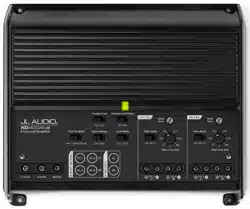Loading ...
Loading ...
Loading ...

8 | JL Audio - XD400/4v2 Owner’s Manual
Do not increase any “Input Sens.” setting for
any channel(s) of any amplifier in the system
beyond the maximum level established during
the procedure outlined in Appendix A (page 14).
Doing so will result in audible distortion and
possible speaker damage.
FILTER CONTROLS
Most speakers are not designed to reproduce
the full range of frequencies audible by the human
ear. For this reason, most speaker systems are
comprised of multiple speakers, each dedicated
to reproducing a specific frequency range. Filters
are used to select which frequency range is sent
to each section of a speaker system. The division
of frequency ranges to different speakers can be
done with passive filters (coils and/or capacitors
between the amplifier outputs and the speakers),
which are acceptable and commonly used
for filtering between mid-range speakers and
tweeters. Filtering between subwoofer systems
and satellite speaker systems is best done with
active filters, which cut off frequency content at
the input to the amplifier. Active filters are more
stable than passive filters and do not introduce
extraneous resistance, which can degrade
subwoofer performance.
The active filter built into each channel section
of the XD400/4v2 can be used to eliminate
potentially harmful and/or undesired frequencies
from making their way through the amplifier
sections to the speaker(s). This serves to improve
tonal balance and to avoid distortion and possible
speaker failure. Correct use of these filters can
substantially increase the longevity and fidelity of
your audio system.
Input Mode
2 Ch.
|
4 Ch.
All
|
3&4
1&2
|
Sum
Preouts From Remote Level Mode
4 Channel Amplifier
Rem.
|
Oset
|
Signal
Input Voltage
Low
|
High
Turn-On Mode
1) “Filter Mode” Controls: The XD400/4v2
employs 12dB per octave filters for each
pair of channels. Each of these filters can be
controlled or defeated completely by way of the
three-position “Filter Mode” switches in each
Channel Section:
“Off”: Defeats the filter completely, allowing
the full range of frequencies present at the inputs
to feed these channels. This is useful for systems
utilizing outboard active crossovers or requiring
full-range reproduction from this channel pair.
“LP” (Low-Pass): Configures the filter to
attenuate frequencies above the indicated filter
frequency, at a rate of 12dB per octave. This
is useful for connection of subwoofers to one
or more of the XD400/4v2’s channel pairs in a
bi-amplified system.
“HP” (High-Pass): Configures the filter to
attenuate frequencies below the indicated filter
frequency at a rate of 12dB per octave. This is
useful for connection of component speakers
or coaxials to one or more of the XD400/4v2’s
channel pairs in a bi-amplified system.
2) “Filter Freq. (Hz)” The filter frequency
markings surrounding these rotary controls
(one in each Channel Section) are for reference
purposes and are generally accurate to within
1/3 octave or better. If you would like to select
the filter cutoff frequency with a higher level
of precision, consult the chart in Appendix B
(page 15).
Tuning Hint: If you are using the XD400/4v2
to drive a subwoofer system (“LP” mode), a
component satellite speaker system (“HP” mode)
or both, 80 Hz is a good baseline “Filter Freq.
(Hz)” setting. After properly adjusting the “Input
Sens.”, as outlined in Appendix A (page 14), you
can fine tune the “Filter Freq. (Hz)” control to
achieve the desired system frequency response.
Loading ...
Loading ...
Loading ...
